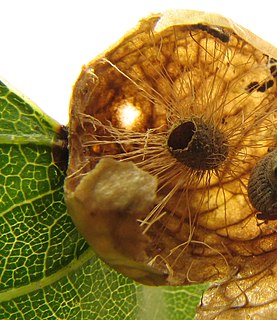
Diplolepis is a genus of approximately 50 species in the gall wasp family Cynipidae. The larvae induce galls on wild roses (Rosa), and rarely on domestic roses.

Gall wasps, also called gallflies, are a family (Cynipidae) in the wasp superfamily Cynipoidea within the suborder Apocrita of the order Hymenoptera. Their common name comes from the galls they induce on plants for larval development. About 1,300 species of this generally very small creature (1–8 mm) are known worldwide, with about 360 species of 36 different genera in Europe and some 800 species in North America.

Cynips is a genus of gall wasps in the tribe Cynipini, the oak gall wasps. One of the best known is the common oak gall wasp, which induces characteristic spherical galls about two centimeters wide on the undersides of oak leaves.

Andricus is a genus of gall wasps in the family Cynipidae, comprising the following species:

Andricus grossulariae is a gall wasp species inducing agamic acorn cup galls on oak tree acorn cups and sexual phase galls on catkins. Synonyms include Andricus fructuum, Andricus gemellus, Andricus intermedius, Andricus mayri and Cynips panteli.

Cynipini is a tribe of gall wasps. These insects induce galls in plants of the beech and oak family, Fagaceae. They are known commonly as the oak gall wasps. It is the largest cynipid tribe, with about 936 to 1000 recognized species, most of which are associated with oaks. The tribe is mainly native to the Holarctic. Cynipini wasps can act as ecosystem engineers. Their galls can become hosts of inquilines, and the wasps themselves are hosts to parasitoids.

Andricus quercuscalifornicus, or the California gall wasp, is a small wasp species that induces oak apple galls on white oaks, primarily the Valley Oak but also other species such as Quercus berberidifolia. The California gall wasp is considered an ecosystem engineer, capable of manipulating the growth of galls for their own development. It is found from Washington, Oregon, and California to northern regions of Mexico. Often multiple wasps in different life stages occupy the same gall. The induced galls help establish complex insect communities, promoting the diversification in niche differentiation. Furthermore, the adaptive value of these galls could be attributed their ecological benefits such as nutrition, provision of microenvironment, and enemy avoidance.
Aphelonyx is a genus of oak gall wasps in the family Cynipidae, comprising three known species:

Atrusca is a genus of gall wasps in the family Cynipidae. It consists of approximately 50 species, and is found in North and Central America.
Bassettia is a genus of gall wasps found in North America.
Synergini is a tribe of tropical gall wasps in the subfamily Cynipinae.

Amphibolips is an American genus of gall wasps in the family Cynipidae. There are about 52 described species in Amphibolips.
Belonocnema is a genus of oak gall wasps in the family Cynipidae. There are two described species: B. treatae and B. quercusvirens. These species are only known from Texas east to Florida in the United States.

Disholcaspis is a genus of gall wasps in the family Cynipidae. There are more than 20 described species in Disholcaspis.

Callirhytis is a genus of gall wasps in the family Cynipidae. There are more than 90 described species in Callirhytis.
Andricus mukaigawae is a species of gall wasp native to southeastern Asia. It creates galls on the buds and leaves of oak trees. The galls are sometimes used by other gall wasps unable to create galls of their own, with both species sharing the gall.
Synergus japonicus is a species of gall wasp in the family Cynipidae. Whereas most gall wasps create the galls in which they live, Synergus japonicus is an inquiline species, living in the gall created by another species of wasp. It is native to Japan, China and Russia.

Andricus quercuspetiolicola, also called the oak petiole gall wasp, is a species of oak gall wasp in the family Cynipidae. Galls in which the larvae live and feed are formed along the midrib or petiole of white oak leaves.
Antistrophus is a genus of about 10 species of gall wasps. The genus is only known from the Nearctic. Species of Antistrophus induce galls on plant species in four Asteraceae genera: Silphium,Lygodesmia, Chrysothamnus, and Microseris.
Philonix is a genus of oak gall wasps in the family Cynipidae. Species in this genus are only known from Canada, the United States, and Mexico. The larvae of Philonix wasps induce galls on white oaks that are typically spherical, soft and fleshy. Galls are usually formed on the underside of leaves. Adult wasps are similar in appearance to species in the genus Acraspis. Many gall wasps have alternate sexual and asexual generations, but this has not been documented in Philonix.












